
Most Recent Posts

The Psychology Behind Effective Billboard Advertising
Billboard advertising is an impactful medium that has the potential to reach countless viewers in high-traffic areas. Despite the rise of digital marketing, billboards continue to hold their ground due to their unique ability to engage audiences quickly and effectively.
Understanding the psychology behind why certain billboard advertisements work better than others can provide valuable insights for marketers aiming to maximize their impact.
1. The Power of Simplicity
One of the cardinal rules of effective billboard advertising is simplicity. A good billboard needs to convey its message at a glance. Most drivers or pedestrians will only spend a few seconds looking at a billboard as they pass by.
Thus, using concise language and clear images is crucial. A well-designed billboard features bold, easy-to-read text complemented by a striking visual that captures attention instantly. This simplicity allows the key message to resonate even with a brief exposure.
2. Emotional Appeal
Emotions play a significant role in decision-making, and this is vital in billboard advertising. Effective ads often tap into feelings of happiness, nostalgia, humor, or even curiosity. By creating an emotional connection, advertisers can make the brand more memorable. For instance, a billboard with a heartwarming image and a relatable tagline can prompt a positive recall of the brand at the moment of purchasing decisions.
3. Creative Use of Color and Imagery
Colors evoke psychological responses and can significantly influence how a message is received. Bright colors can capture attention, while softer tones might convey calmness or trust. Understanding color psychology allows brands to choose hues that align with their messaging and branding, reinforcing what they stand for.
4. Strong calls-to-action
A direct call-to-action (CTA) is essential to guide consumers to the next step after seeing the billboard. Whether encouraging viewers to visit a website, scan a QR code, or engage with the brand on social media, a strong CTA effectively prompts immediate actions. CTAs are especially powerful when they leverage urgency or exclusivity, motivating potential customers to act quickly.
5. Targeting and Context
Effective billboard advertising is not just about the design; where and when the billboard is placed play an essential role in its success. By considering the demographics of the area, advertisers can tailor their messages to resonate with the local audience.
For example, a family-friendly event advertisement would be more effective in a neighborhood with families. Additionally, aligning the message with what consumers are likely to be doing when they see the billboard (e.g., morning commutes, weekend outings) enhances its relevance.
Billboard advertising remains a powerful marketing tool when crafted with psychological principles in mind. Simplicity, emotional appeal, strategic use of color, strong calls-to-action, and careful targeting are all vital components that contribute to the effectiveness of a billboard.
By understanding these psychological elements, brands can create impactful billboard advertisements that not only capture attention but also convert viewers into customers, ensuring their messages resonate long after they have passed by.